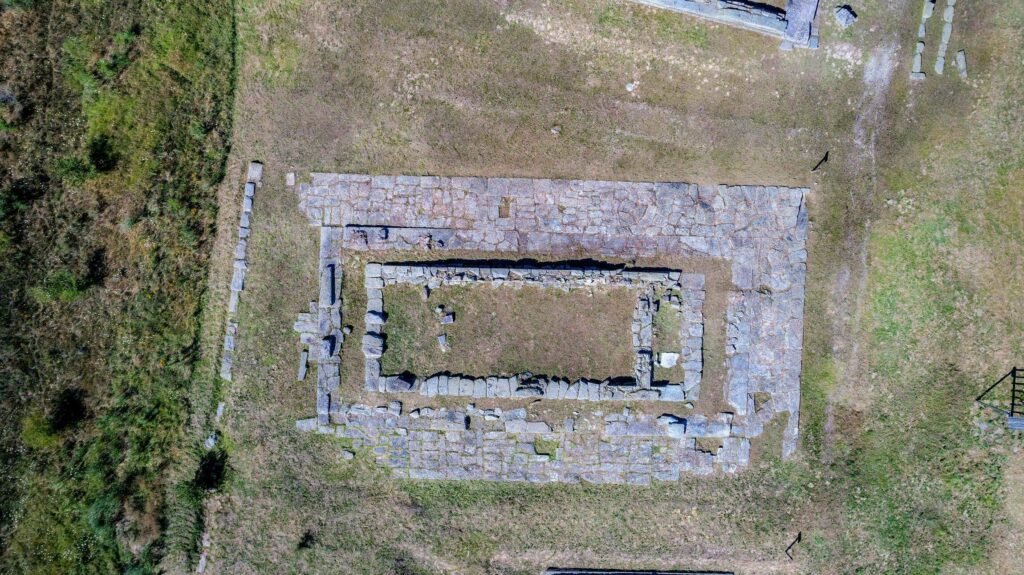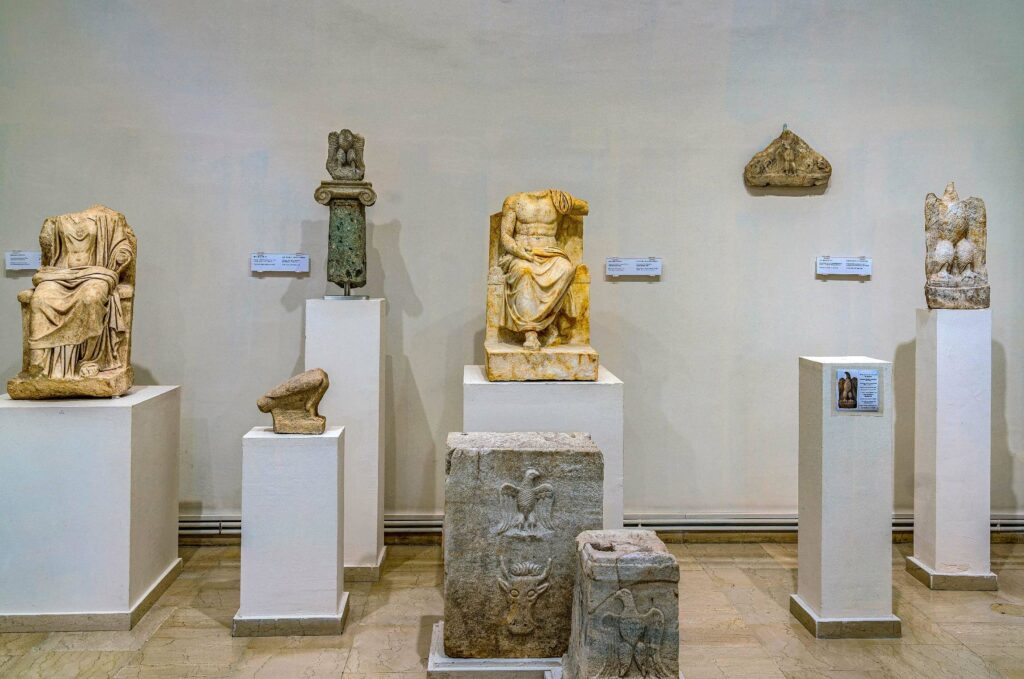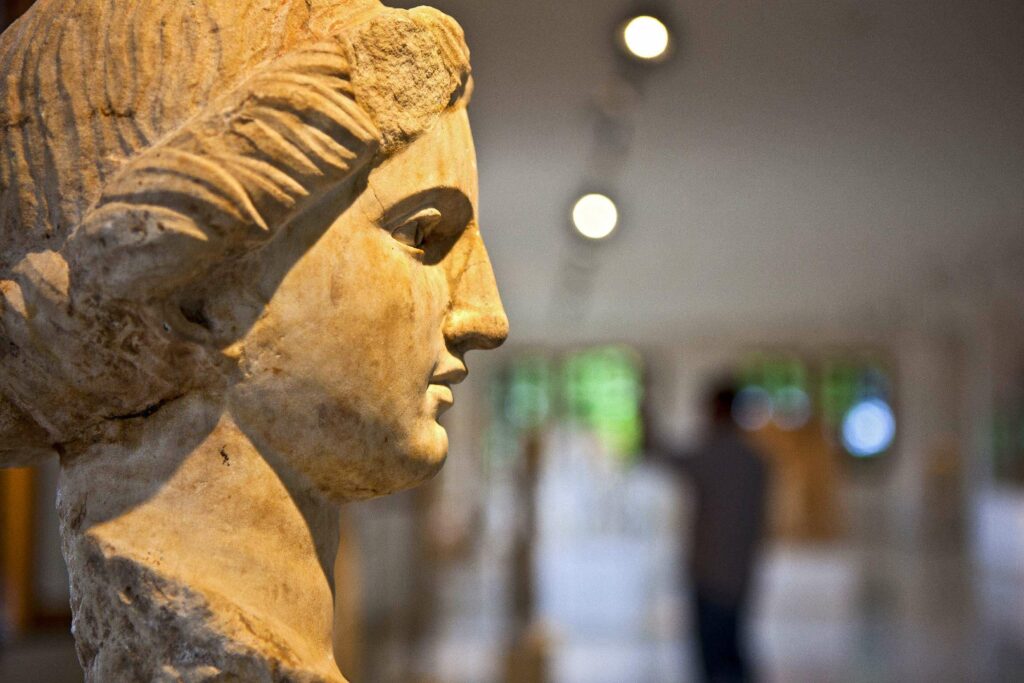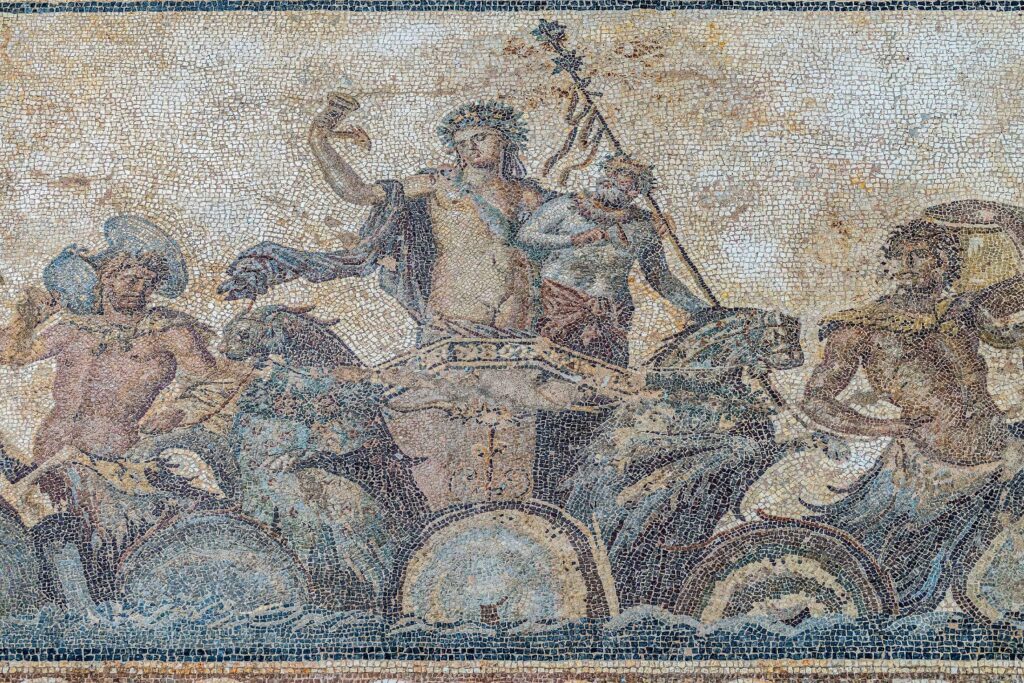MOUNT OLYMPUS
Home » THE MOUNTAIN » Mythology
Towering up from the centre of the Greek civilisation, monument of world nature, the imposing mount Olympus, the highest mountain in Greece, is the symbol of the Greek spirit as well as of faith and freedom.
Being the residence of ancient gods, Olympus was the cradle of poetical and mythological intrigues between gods and heroes of the antiquity. It won eternal fame and glory all over the world up to our times through ancient literature and modern classicism. It is the most well-known mountain in the world, a symbol of global civilisation, an attractive destination and shrine for Greeks and foreigners who can withstand hard ascents.
The first Greek tribes had already settled on the highlands and the narrow plains, surrounding the main massif of Olympus, in the 3rd millennium B.C and in the early part of the 2nd millennium B.C the Greek tribes surged from the settlements near Olympus towards all over the Greek mainland, as vehicles of the so called Mycenean civilization. The Olympic religion, myths and names, memories and place – names of Olympus, which can be met all over Greece, shaping the common ancient Greek mythology, religion and philosophy concerning the creation of the world.
Olympus’ slopes have been a refuge for persecuted and fighters, from the antiquity till the tragic conflicts of the Second World War, and therefore it still remains a symbol of resistance and freedom for the Greeks. Whenever the country was under foreign occupation, rebels and resistants could live in freedom in the villages and monasteries of Olympus, its forested slopes being bases of operation for liberation struggles and revolutions. It is the diachronic Greek sacred symbol of life and national survival.
Olympus, with its natural beauty, its mythological and historical fame, its alluring – for contemporary nature lovers – routes, still remains an “Ithaka”, the ultimate and ambitious end for climbers all over the world. An ascent of Olympus is more than a simple conquest of a high peak, it is a top-ranking ascent on the world’s mythical beginning of the world.
Through the cultivation, revival and presence of Olympic myths in the world’s art, literature and education, ancient gods and heroes are present, they mentally accompany the climbers, appear next to sources and peaks, boost the will of the spiritless during their routes. Olympus, along with Sinai, Ararat, Mt. Calvary and Mt. Athos, remain in global civilisation mountains-symbols of human faith and longing for birth, existence and divine supervision of their life.

Thousands of climbers reaching the summit of Olympus, Mytikas, exhausted due to the difficulty of the ascent, have gazed the superb surroundings from the same location where the twelve gods used to survey the world. It is on this summit where people’s imagination and ancient Greeks’ philosophical exploration imagined them to be. Among a multitude of gods and heroes that constitute the Greek Pantheon, the ancients had chosen twelve gods, the most representative and reliable ones, and placed them in the Olympic Palace, as protectors, but most of all as their judges. Zeus, Hera, Athena, Poseidon, Demeter, Apollo, Artemis, Hermes, Ares, Hephaestus and Hestia. Around the twelve Olympic gods, there are tens of other gods and semi – gods who discuss, have transactions, fight with each other and fall in love with the eternal great gods. The Muses and Orpheus, who taught and protected fine arts, belonged to the minor mythical figures of Olympus.
The twelve Olympic gods were human – like and had all human qualities and shortcomings, passions, weaknesses, love affairs, hates and affinities. Even the structure of the Olympic religion, which took its final form by the poets Hesiodus and Homer at the 8th century B.C., shows similarities to the government and organisational structure of the royal family during the antiquity. It is characterised by social classes, royal appearance, sceptres and symbols, assistants and messengers, who carry messages to immortals and mortals. Most of them were linked by familial or love ties. Consequently, Hera, Zeus legitimate spouse, was at the same time his sister, and so was Hestia. The children of Zeus and Hera were Athena, Apollo and Ares whereas Poseidon was Zeus’ brother.
Zeus or Dias was the leader of the twelve gods, the“ father of gods and humans”, according to Homer, king and governor of Olympus, the winner of the war against giants and titans, the one who defeated his father Cronus and drove Titans and Giants at Tartarus. Although being ruler –as he was afraid of conspiracies against him – he lived in spacious rooms, similar to the luxurious, secular, royal palaces. He was the god of Uranus (Sky), the ruler of meteorological changes, the one who controlled rain and thunders but also the merciless punisher of the arrogant and just protector of foreigners and fugitives.
The adjectives which poets created in order to describe Zeus are innumerable and they determine the god’s powers and initiatives but also reveal the abilities, the names and the characterisations which the people attributed to the great god: “akreos” (on the tops of the mountains), “xenios”, “nefeligertis” (who masters clouds together), “kelenefis” (in a bad mood), “argikeravnos”, “omvrios”, “terpikeravnos” (who takes pleasure at thunders), “ietios” (rainy) and others.
Being the god of insemination, Zeus had many love affairs with goddesses, nymphs, heroes, but even with common people, in order to serve the popular belief that Zeus was the patriarch and ethnic leader of the Greeks. Among the god’s sexual activity is included his keen love for the handsome teenager Ganymede, the son of Troas, whom he seized from Troy and confined in the amorous palace of Olympus.
Hera was the wife of Zeus, protector of marriage and marital ties, one of the most respectable ancient goddesses. She was the daughter of Cronus and Rhea, and, consequently, Zeus sister! She appears to be defending women but at the same time a tough punisher of her husband’s mistresses and their children, as was the case of Leto and Semele.
Athena, who was initially goddess of war, and was attributed adjectives such as “promahos”, “nikiforos” and “sotira”, armoured with a helmet, a shield and a spear, turned into the protector of handicraft and fertility and became the patron saint of Athens and the symbol of wisdom.
Poseidon, god of the sea, of drinkable waters and sources, is the brother of Zeus who may stir or smooth the sea with his trident. He possesses a palace on the peak of Olympus and another golden one, in the bottom of the sea, with his wife Amphitrite. The Greeks being a seafaring people, worshipped Poseidon as a chief exponent god of the sailors, the “pelagios” (of the ocean) and “pontios” (of the sea), and he was considered responsible for various geological phenomena and earthquakes, he was “geis kinitir” and “Sisihthon” (who shakes the earth).
Demeter was the goddess of vegetation and agriculture mainly protecting the crops of cereals and the rural class. In mythology, she is more well-known as the mother of Persephone, who was seized by Plutus, the god of the under world. Demeter was so furious at her daughter’s abduction that gods decided that Persephone should stay in Hades for only four months and the rest of the year on earth. Mother and daughter sit by the throne of Zeus offering good crops to the people they love, by sending Plutus to them.
Apollo, son of Zeus and Leto – a titan’s daughter, initially the god of shepherds, fertility and harvest, became the god of light and harmony. Born on Delos, he ascented Olympus the very first day, where the other co-habitant gods welcomed him with respect. Once, Apollo descended from the twelve gods’ residence, passed through the western side of the mountain, where Perevi lived, and after wandering for long, he arrived at Delphi, killed the fearful serpent which guarded the sources and established the first oracle. The laurel, which grows at the foot of Olympus and on the plain of Pinios, is Apollo’s holy tree with the leaves of which the wreath for his hair is made of. Apollo once met Daphne by the river, the daughter of Pinios river, for whom he felt lust. She run away and, in order to escape herself from his mania, she begged her father to transform her into a plant. Apollo had love affairs with the muses Thalia and Calliope, who lived on Olympus and on Pieria mountains, and with other nymphs who gave birth to Orpheus, Asclepius, Hymen as well as to other heroes and semi – gods. The god of light is tied to music. He used to amuse the Olympic gods by playing his lyre, while the Muses, Graces and Hours were dancing during the Olympic symposiums.
Artemis, Twin sister to Apollo, she was goddess of chastity, virginity, the hunt, the moon, and the natural environment. She is very beautiful and affectionate, she hunts using her golden bow, although being a friend of the animals, and she dances with the Muses and the Graces at gods’ symposiums.
Hermes, son of Zeus and nymph Maia, is his father’s messenger who brings messages to gods and people. Protector of merchants, wayfarers and wrestlers, became later on the god of the spirit. He was worshiped by the ancients as “kerdoos” and also as “logios Ermis” (literate Hermes). He was wing – footed in order to carry his messages, as well as the pallbearer of the souls to Hades and an affectionate protector of sleep.
A martial god, Ares, unlike his sister does not represent sobriety, but mania, the irrationality of war, and at the same time cowardice. That explains why his children are called Deimus and Phobus (fear). Nevertheless, despite the savageness they attribute to Ares, poets imagined him falling in love with Aphrodite, who gave birth to… Harmonia! As one could imagine, no city wanted him as a patron saint. He was the apotheosis of war sufferings and human misfortune.
Aphrodite, daughter of Zeus and Dione, was the apotheosis of feminine beauty, goddess of erotic life and love. Very beautiful as she was, she was accompanied by small deities in the Olympic palace and during her erotical explorations: Hebe, Himerus, Pothos. Everybody, mortals and immortals were victims of her erotic plots: Ares, Poseidon, Dionysus, even the crippled Hephaestus. She fell in love with the beautiful Adonis and, for his sake, she got down to earth, going hunting with him. When a wild boar killed the beautiful man, she burst into tears from which anemones grew up. Harmony and Eros, and even the ugly god of fertility, Priapus, are children of Aphrodite. Her attractive body with the long neck and the adorable breasts, has been an everlasting model and art theme for sculptors and painters, “Aphrodite of Milos” being a top-ranking sculpture, dated back to the 2nd century B.C., now kept in the museum of Louvre.

Apart from the main twelve gods there are tens of other deities, such as Asclepius, Hestia, Hades, Gaea, Rhea, Helios, Iris, Cybele, Hebe, Myrrha, who serve the most distinctive gods, the “royal” divine family.
Groups of other deities are in their service, such as the Muses, the Sirens, the Graces who accompany the gods, the Nymphs, mainly Oreads (mountain nymphs), Gorgons, Cabiri, Winds and Pleiades.
The Muses, in particular, are attached to Olympus and the neighbouring Pieria where they were born, that is why they are called Pierides, Pimbliides (from Pimblia), Livithrides (from Livithra), and Olympiades. Born all nine together by Zeus and Mnemosyne, daughter of Gaea and Uranus, the Muses represent the fine arts. They lived on Olympus, sang sweetly and were the only ones to play the lyre together with Apollo who was called Mousagetis (leader of the Muses). Each Muse cultivates and protects a sector of the arts. Leading Calliope is the muse of epic poetry, Melpomene of tragedy, Thalia of comedy, Terpsichore of dance, Euterpe of lyric poetry, Clio of history, Erato of love poetry, Polyhymnia of songs to the gods and Urania of astronomy, which was rather considered as an art than as a science in antiquity.

The area close to Olympus and Pieria is the homeland of Orpheus, a legendary poet and musician, which had a great appeal on the ancients and even attracted the attention of Christian philosophy. He was a magician, a mystic, a priest and an exquisite musician. His music enchanted the trees and rocks and tamed wild beasts, and even the rivers turned in their course to follow him.
Son of the Muse Calliope by Oeagrus, a king of Thrace, he was born in Pimblia, a town at the foot of Olympus, next to Litochoro. He died and was buried in the neighbouring town of Livithra, in the gully of Kanales, where mystical ceremonies used to take place in a special edifice for orgies in honour of Orpheus and Dionysus.
According to the mythical tradition, a fierce band of Thracian women, who were followers of the god Dionysus and had been excluded from the orgies, as being an exclusive male occupation, came upon the gentle musician and killed him. He was buried at the place where he had been assassinated and his tomb became a place of worship.
He married the lovely nymph Eurydice. Soon after the wedding the bride was stung by a viper and died. Orpheus determined to go to the underworld and try to bring her back, something no mortal had ever done. Hades, the ruler of the underworld, was so moved by his playing that he gave Eurydice back to Orpheus on the one condition that he not look back until they reached the upperworld, but Orpheus could not control his eagerness and as he gained the light of day he looked back a moment too soon, and Eurydice vanished. His myth created a whole religious and philosophical movement, according to which the human body constitutes a harsh prison, liberated after death.
Olympic myths will always be inspiring for the Greeks as well as for other people, at their effort to interpret life and its laws and to express their anxieties and existential fears through divine anticipation. Mythological Olympus still affects and inspires intellectuals, literary figures and artists and remains in the thought of contemporary man as a holy mountain, a universal symbol of eternal philosophical exploration concerning the world’s creation and existence.
